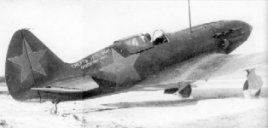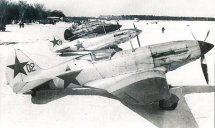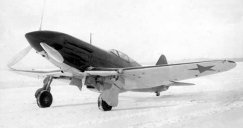
Mikoyan-Gurevich Mig-1/3
If they had not used the scarce Mikulin AM-35 engine, the MiG-1 and MiG-3 fighters might have served the USSR for much longer than they actually did. Unusually for wartime Soviet fighters, they performed better at altitude than at low level, and for this reason were often used as high-flying reconnaissance aircraft. More importantly, these warplanes launched the Mikoyan-Gurevich design bureau, the first to bear the immortal MiG name.
MiG's first fighters were capable machines that fell foul of the requirement for an inline engine. The basic design was fairly capable and the prototype (I-200), powered by a Mikulin AM-35 engine, was the equal of a Spitfire or early Bf 109.
The urgent demand for modern fighters to replace the Polikarpov I-16 set production going in 1940, despite some early handling problems. The first units were operational by the time of the invasion in 1941.
The weakness of the MiG-3 was that it shared the Mikulin AM-35 engine with Ilyushin's Il-2 Shturmovik. Stalin and his generals decreed that the Il-2 had absolute priority and sent threatening telegrams to factory managers who continued to produce MiGs instead of Il-2s. Consequently, production was terminated in 1942, after only 3120 aircraft had been built.
Attempts to fit radial engines proved unsuccessful as they only added to the MiG's unforgiving reputation. This resulted in many Migs being promptly replaced by Yak and Lavochkin fighters.
Despite its failure, the MiG proved useful in combat, giving a good account of itself when fighting above heights of 5000 metres. At lower altitudes, where much of the fighting took place, it was not quite the equal of the Fw 190 or Bf 109F.
 |
 |
 |
| The l-211 was an attempt to match a radial M-82 engine to a MiG-3 airframe. It was proved successful but by this time the rival La-5 was in mass production and required these radial engines. |
By the time of the German invasion in June 1941, 13 fighter units had been fully equipped with the MiG-3. |
Demand for modern fighters was such that the l-200 prototype was built in just 100 days from first drawings. |
|
Mikoyan-Gurevich Mig-1/3 (Technical Specification) |
| Role |
Single-seat fighter |
| Manufacturer |
Mikoyan-Gurevich |
| Maximum Speed |
640 kmh (397 mph) |
| Maximum Range |
1,195 km (743 mil) |
| Ceiling |
12,000 meters (39,400 feet) |
Weight
Empty
Maximum Takeoff |
2,595 kg (5,709 lbs)
3,350 kg (7,370 lbs) |
Dimensions
Wingspan
Length
Height
Wing Area |
10.20 meters (33 ft 9 in)
8.25 meters (20 ft 9 in)
3.50 meters (11 ft 6 in)
17.44 square meters (188 sq ft) |
| Engines |
One Mikulin AM-35A V-12 piston engine which provides 1007-kW (1,350 hp) |
| Armament |
One 12.7 mm (0.50 cal) Beresin
Two 7.62 mm (0.30 cal) ShKAS machine-guns
200 kgs (440 lbs) of bombs
Six RS-82 rocket projectiles on underwing racks |
Photo Gallery
Click here to submit your photo
| Have A Passion For Aircraft? |
Subscribe to our 14 series FREE newsletter
delivered weekly on World War 2 Aircraft factfile... |
| NB:- We hate spam as much as you do, so your email address will NEVER be shared with or sold to anyone else. That's a Guarantee. |
|
|





